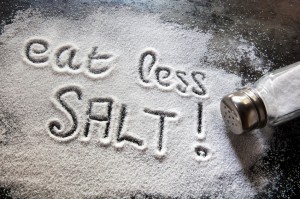Sunday, November 9, 2014
Help your heart by skipping the salt
The Lake County General Health District visited us last week and suggested ways in which people can prevent or control high blood pressure.
One of their tips was to eat less salt.
While we need salt to live, most people eat way more salt than they need. The recommended daily amount of salt is 2,300 milligrams or about one teaspoon.
And it can be difficult to eat less salt. First of all, it's delicious. Secondly, it seems as if it's in everything.
So Lake County General Health District, with some help from the USDA, offered 10 tips for cutting back on salt.
1. Think fresh
Processed foods—like cured meats, pizza, canned soup and chili—tend to have more salt than fresh foods. You don't have to cut out all processed foods, but eat fewer of them and more fresh food.
2. Enjoy home-prepared foods
If you cook at home, you'll be in control of your food and know exactly how much salt is in there.
3. Fill up on vegetables and fruits
Vegetables and fruits—fresh or frozen—are naturally lower in sodium. Eat them with every meal. (Keep an eye on canned vegetables though. They sometimes have sodium added.)
4. Choose dairy and protein foods that are lower in sodium
Fat-free and low-fat milk has less sodium than cheese. Similarly, fresh beef, pork, poultry and seafood has less sodium than deli meat or sausages. Also, opt for unsalted nuts and seeds.
5. Adjust your taste buds
If you suddenly cut back on all of your salt, you'll be jones-ing for a deli sandwich and french fries in no town. Cut back on your salt a little at a time and your taste buds will adjust to this new normal.
6. Skip the salt
This one seems obvious, right? Just leave the salt off the kitchen counter when you're cooking and the dinner table when you're eating, and you'll be less tempted. Try other spices and herbs like red or black pepper, basil, curry, ginger or rosemary, instead.
7. Read the label
Processed food is convenient, but it can also be unhealthy. Read the label and know exactly what you're eating.
8. Ask for low-sodium foods when you eat out
Eating out can be tricky because, once again, you can't completely control what's in your food. However, you can always ask for a lower sodium version of a food, sauce or salad dressing.
9. Pay attention to condiments
Foods like soy sauce, ketchup, pickles, olives, salad dressings and seasoning packets are high in sodium. Choose a low-sodium version of your favorite condiment and substitute carrots or celery sticks for pickles and onions.
10. Boost your potassium intake
Potassium is known to lower high blood pressure. Most people know that bananas have potassium, but so do potatoes, beets, greens, tomato juice and sauce, sweet potatoes, beans and orange juice.
Here are 10 tips for building a healthy meal from Lake County General Health District.
Subscribe to:
Post Comments (Atom)

No comments:
Post a Comment